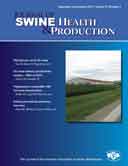Abstract:

US swine industry productivity analysis, 2005 to 2010
Mark T. Knauer, PhD; Chris E. Hostetler, PhD
Complete article is available online.
PDF version is available online.
Objective: To quantify US swine production trends for sow-farm and grow-finish traits from a large available database.
Materials and methods: Data were provided by a data management company, representing annual production of approximately 1.8 million sows in the United States. Sow-farm traits included pigs per mated female per year, litters per mated female per year, total number born, number born alive, number weaned, preweaning mortality, weaning age, weaning weight, replacement rate, culling rate, sow mortality, lactation-feed intake, and gestation-feed intake. Grow-finish traits included entry age, entry weight, exit age, exit weight, average daily gain, feed efficiency, caloric efficiency, and mortality.
Results: From 2005 to 2010, pigs per mated female per year, litters per mated female per year, number born alive, number weaned, weaning age, weaning weight, and lactationfeed intake increased (P < .05). Sow mortality decreased (P < .05) and replacement rate did not change (P > .05). Entry age and entry weight increased (P < .05) for nursery and wean-to-finish pigs. Average daily gain improved for nursery and finishing production (P < .05), but not for wean-to-finish (P > .05). No improvements were made for finishing caloric efficiency (P > .05), and wean-to-finish caloric efficiency worsened (P < .05). Mortality for both finishing and wean-to-finish operations improved (P < .05).
Implications: Both scientists and producers can use these results to better understand US sow-farm and grow-finish production levels. Pig industry trends from 2005 to 2010 indicate varied degrees of improvement for pig production traits.
Keywords: grow-finish, sow, production, trend
![]() Cite as: Knauer MT, Hostetler CE. US swine industry productivity analysis, 2005 to 2010. J Swine Health Prod 2013;21(5):248-252.
Cite as: Knauer MT, Hostetler CE. US swine industry productivity analysis, 2005 to 2010. J Swine Health Prod 2013;21(5):248-252.
Search the AASV web site for pages with similar keywords.
